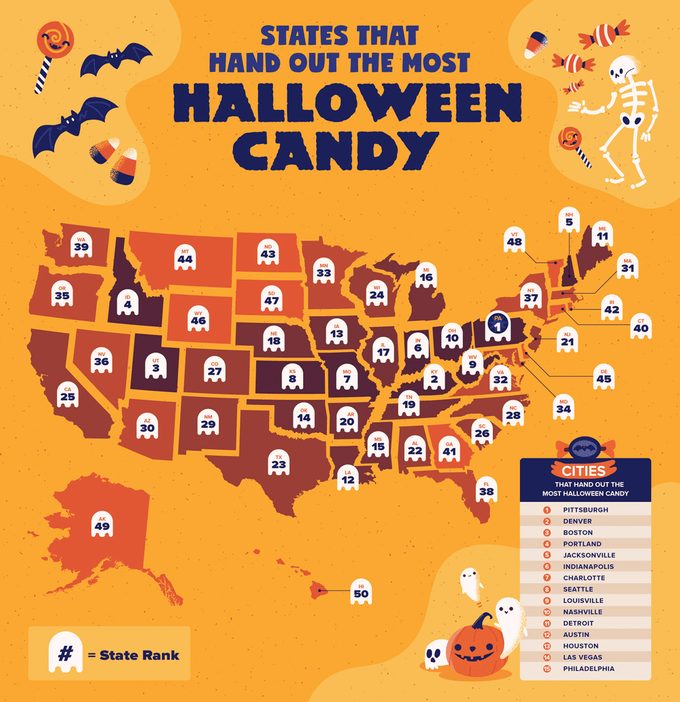Where you live has a lot to do with how much Halloween candy you'll bring home on Oct. 31. Find out how your state stacks up.

These Are the States That Give Out the Most Halloween Candy—See Where Yours Ranks

Trick-or-treaters, take note: Two-thirds of Americans plan to pass out candy this Halloween, and they’re already stocking up. Shoppers are expected to spend $3.5 billion on Halloween candy this year, according to a 2024 National Retail Federation survey. That’s only a slight drop from last year’s $3.6 billion.
But not every state gets as deeply invested in Halloween. In fact, the state where you live might determine how much candy you collect on Oct. 31. To find out which states lead the pack when it comes to sweet treats, CouponBirds analyzed more than 1,000 Google search terms, then factored in volume per capita so each state was represented equally.
As you break out your pillowcases, plastic pumpkins and reusable tote bags to get ready for the spookiest day of the year, you might be surprised to learn which states give out the most Halloween candy—and which states are more trick than treat. Keep reading to find out where your state falls on the list.
Get Reader’s Digest’s Read Up newsletter for more holidays, humor, travel, tech and fun facts all week long.
Which states give out the most Halloween candy?

Drumroll, please! Pennsylvania residents certainly love their sweets. The state gives out the most Halloween candy in the country.
While CouponBirds didn’t delve into people’s reasons for handing out candy, we can take a guess: Pennsylvania has been home to the Hershey Company, headquartered in the city of Hershey, since 1905. Perhaps Pennsylvanians take their chocolate history seriously.
Kentucky comes in a close second, which might be surprising to anyone unfamiliar with Kentucky’s candy history. The state is home to a wealth of treats: It’s where classic sweets, like pulled cream candies from century-old confectionery Ruth Hunt Candies, originated.
Rounding out the top five are Utah, Idaho and New Hampshire.
- Pennsylvania
- Kentucky
- Utah
- Idaho
- New Hampshire
Which states give out the fewest Halloween candies?
At the other end of the spectrum are Hawaii and Alaska, the two states that give out the fewest Halloween candies. It’s not because residents of these states prefer non-candy Halloween treats, though. While plenty of people across the Aloha State and the Last Frontier have a soft spot for chocolate bars and Twizzlers, the lack of Halloween candy love may be due to the high cost of importing goods from the contiguous United States.
Vermont, South Dakota and Wyoming are among the other states to give out the least candy. That may be due in part to the fact that they’re among the least populous states in the country.
- Hawaii
- Alaska
- Vermont
- South Dakota
- Wyoming
How does your state rank for Halloween candy?
Wondering where your state falls when it comes to Halloween candy? Check out the list below before you go trick-or-treating.
- Pennsylvania
- Kentucky
- Utah
- Idaho
- New Hampshire
- Indiana
- Missouri
- Kansas
- West Virginia
- Ohio
- Maine
- Louisiana
- Iowa
- Oklahoma
- Mississippi
- Michigan
- Illinois
- Nebraska
- Tennessee
- Arkansas
- New Jersey
- Alabama
- Texas
- Wisconsin
- California
- South Carolina
- Colorado
- North Carolina
- New Mexico
- Arizona
- Massachusetts
- Virginia
- Minnesota
- Maryland
- Oregon
- Nevada
- New York
- Florida
- Washington
- Connecticut
- Georgia
- Rhode Island
- North Dakota
- Montana
- Delaware
- Wyoming
- South Dakota
- Vermont
- Alaska
- Hawaii
Why trust us
At Reader’s Digest, we’re committed to producing high-quality content by writers with expertise and experience in their field in consultation with relevant, qualified experts. We rely on reputable primary sources, including government and professional organizations and academic institutions as well as our writers’ personal experiences where appropriate. We verify all facts and data, back them with credible sourcing and revisit them over time to ensure they remain accurate and up to date. Read more about our team, our contributors and our editorial policies.
Sources:
- CouponBirds: “The Sweetest States and Spookiest Cities: Halloween Candy and Decorations Galore”
- National Retail Federation: “Nearly Half of Halloween Shoppers to Start Purchasing Items Before October”
- National Retail Federation: “Halloween Spending to Reach Record $12.2 Billion as Participation Exceeds Pre-Pandemic Levels”
- Milton Hershey School: “Milton S. Hershey History”
- Ruth Hunt Candies: “Shaping Kentucky’s Confectionery History”























